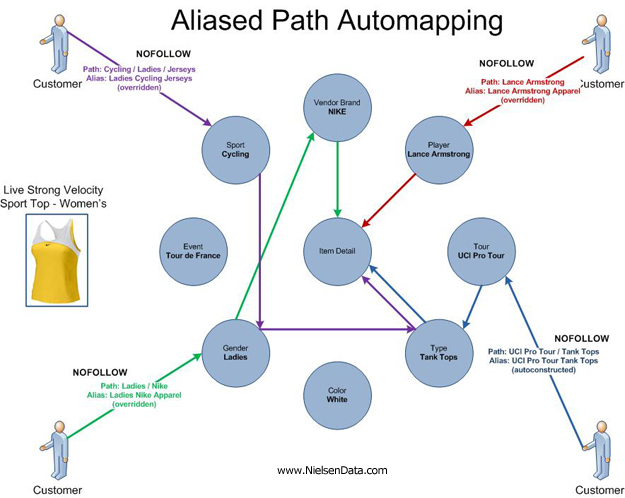This is the fourth installment in a series that blends website architecture, data structures, and SEO marketing into a collaborative design pattern continuing from Part 3 - Best Business Practices for Product Catalog Data Structures - Customer Paths.
It may seem counterintuitive to discuss search engine optimization (SEO) techniques in the midst of a conversation about data structures, architecture diagrams and in-store plan-o-grams, but it can directly relate to your choice of data models. As we discussed in the previous article, it is important to structure your website to conform with the needs of entering customers in a way that segments them properly so they find the things that they were searching for. Part of this is anticipating what a customer is going to want before they enter your store.
When dealing with search engines, there are two customers to contend with... the "Natural" search engine... and the "Paid" search engine. These two customers are very important to understand and to distinguish and need to be treated with a deference and distinction from the "real" customers that frequent your online store. The complexity arises to some degree because these two "customers" happen to be "ghost shoppers". You never know when they are going to arrive and they generally float through your store much like a customer would, but they are searching for every product on every shelf in every aisle and in every department... all at the same time. The complications continue because you want to manage what the ghost shoppers can and cannot see so they don't memorize portions of the store that you don't want reported on the search engines. This may come across as elemental theory to an SEO expert, but in the context of blending SEO concepts, architecture and data structure modeling, it illustrates one aspect of the equation.
Imagine now that you are a search engine, whose job is to find, identify and classify billions of e-commerce pages throughout the Internet with the primary objective of finding pages that are considered "relevant." I quote the term "relevant" because what that precisely means changes with the breeze and the whim of arcane departments of voodoo at the various search engine optimization firms. With that said, you want to look at a natural search engine as a stream of water pouring into your website. This stream is going to remember whatever it touches, so you want to ensure that it finds the things that you want it to see. You also need to consider the diffusion of the stream of water as well. Don't let the natural search engine stumble across pages like "Privacy Policy" or "Terms & Conditions" as that won't deliver any tangible benefit for you. In similar fashion, on your landing pages you should try to structure your site so the links that are the most compelling draws for the majority of natural searching customers should be setup to receive the largest stream of natural search "attention."
You also need to anticipate every possible combination of keywords that would be used to "land" on any given destination. Lets take a look at the SEO Path Aliasing diagram to illustrate that:

We have already covered Customer Paths but sometimes the proper "path name" doesn't match an actual English phrase. This means that the combinations of words that make sense for categorizing a mix of products may not make linear sense for a keyword search. Our diagram above illustrates this with the green path of "Ladies / Nike". There may not be many customers that would enter that phrase in a search, but it may be a logical progression as they navigate through a website. This is where Aliased Paths come in. In our example, the Aliased Path for "Ladies / Nike" could be "Ladies Nike Apparel"... sure this one is a bit of a stretch... I'm not sure how many actually type in the word "apparel" but you'll need to work with me on this one.
You will note that this path is identified as "overridden". In smaller e-Commerce websites, it may be a simple matter to manually go through each Customer Path and identify the possible Aliases but in far larger catalogs this quickly becomes a daunting task. It doesn't mean that overridden Path Aliases aren't an important part of configuring your catalog categorization scheme, but you can, for the most part, rely on the auto-generated Path Aliases for many of the Customer Paths in your catalog. Take the path "UCI Pro Tour / Tank Tops" which easily converts to an English text keyword search of "UCI Pro Tour Tank Tops".
Note also our attempt to focus the "stream" of the natural search flow throughout the various Customer Paths. Many search engines respond to a setting within the hyperlinks of a "NOFOLLOW". This mechanism gives you some measure of control over which links you allow the natural search "probing" to find. You will note how the various Customer Paths are identified as NOFOLLOW for those paths that we want the search engines to pass on as they traipse through our pages. This poses another logistical issue in a large-scale e-Commerce website which we will address in the next segment, Part 5 - Best Business Practices for Product Catalog Data Structures - SEO Weighted Auto Mapping